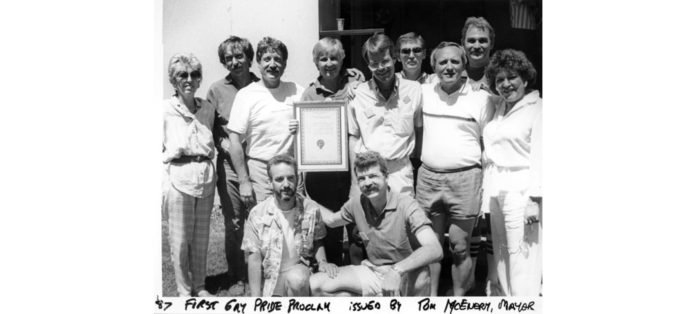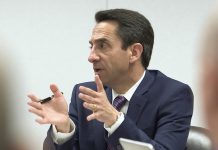
Little is known about the life of late local photographer Ted Sahl. He was born in 1927 and grew up outside of Boston. He served in the Navy in 1947 and later moved to the Bay Area, where he began taking pictures in the 1960s. After his death in Campbell sometime in the mid-2000s, Sahl’s archives were donated to San Jose State University’s King Library Digital Collections, which houses more than 12,000 of his images.
But we can learn more about Sahl through his photography, thanks to New Museum Los Gatos’ new exhibit, Snapshots of Pride: Photographer Ted Sahl’s Chronicle of the South Bay LGBTQ+ Community, which runs May 30 through Oct. 5.
The collection features paintings, drawings, poetry, newspaper clippings, personal items and a copy of his 2002 book, From Closet to Community: A Quest for Gay & Lesbian Liberation in San Jose and Santa Clara County, not to mention approximately 70 photographs, mostly from the 1970s and ’80s, organized according to politics, activism, culture, the AIDS crisis and other subjects.
“I want people to understand that this gentleman took 12,000 photographs in his own time and with his own money,” says exhibit curator Amy Long. “There were unique things happening in this area, and without those photographs, we would have probably almost no record of what was going on down here aside from people’s yellowed photo albums in their junk drawers. This is an absolutely incredible, massive historical record for the South Bay area to have.”
Sahl SPent decades photographing council meetings, protests, voter registration Drives, AIDS clinics, candlelight vigils and more
Sahl was photographing anti-war, anti-nuclear and farm labor strikes when, in 1978, he stumbled on a clash between gay men and women and members of religious groups. The San Jose City Council planned to declare Gay Pride Week for the first time in 1978, two years after the city’s first pride parade, but the idea was met with opposition. San Jose didn’t declare Gay Pride Week until 2001.
Sahl would spend the next 30 years photographing city council meetings, protests, voter registrations, AIDS clinics, candlelight vigils, parades, beauty pageants, leather contests and male and female impersonators, working for such publications as Lamda News, the South Bay News and Valley View Magazine. He documented key events and notable figures who were part of the evolution of the gay community in and around San Jose.
People like Los Gatos activist and SJSU professor Wiggsy Sivertsen and Desperados club owner Billy DeFrank—a well-known African-American drag performer, for whom the Billy DeFrank LGBTQ+ Community Center was posthumously named. Sahl also shot plenty of famous folk, namely Allen Ginsberg, Joan Baez, John Waters star Divine and legendary theater troupe the Sisters of Perpetual Indulgence. One image of San Francisco supervisor Harvey Milk shows him at Gay Pride San Jose in 1978, the year he was assassinated.
“Desperados was in a mini mall,” Long recalls. “But it became extremely important. Downtown San Jose in the ’80s was literally tumbleweeds. There was nothing happening downtown. There was no core street or area. So to have those community centers, events, organizations, publications and gay bars became even more critical. You had to get in your car and go be with your people. You couldn’t just walk out your door and sit on your front step and have a parade. It took a little more effort and organizing, which is really important.”
Long hopes to show viewers of the exhibit that San Jose, like many other small towns, has helped shape the history of the gay pride movement as much as big cities have.
“We hear a lot, and with good reason, about San Francisco, New York and L.A.,” Long says. “But I want people who live here to know that on a local level, the fight was just as important, just as significant. And on some levels, harder. And it happened in their backyard.
“The suburbs are a microcosm of what goes on nationally,” Long continues. “If you can reach the suburbs and can get to the Joneses, and be accepted in your neighborhood, that helps move things along in our society. So the whole topic of a gay community and gay liberation in the suburbs has a different level of significance. It’s not better, not worse. It’s not about competition. It’s just different. It’s a whole different flavor.”









